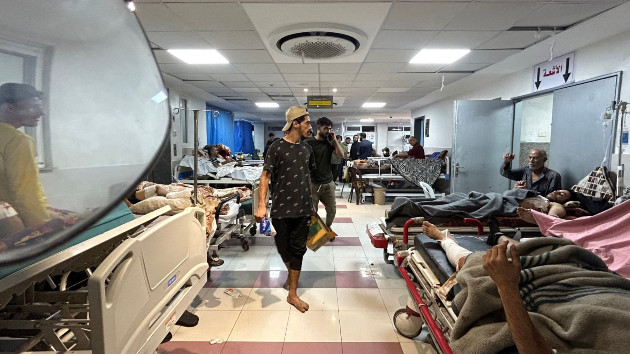Israel-Hamas war is ‘deadliest conflict for journalists’ since at least 1992, CPJ says
Written by ABC Audio All Rights Reserved on November 16, 2023

(NEW YORK) — Reuters journalist Issam Abdallah was standing near the Lebanon-Israeli border on Oct. 13, a Friday afternoon six days into the current conflict in Israel, doing what he did best: cover war zones from the Middle East to Ukraine.
On this day, he was providing a live signal for a Reuters crew amid back-and-forth shelling between Israeli forces and Hezbollah, according to Reuters.
Amid the shelling, Abdallah, a Beirut-based videographer, was killed by a missile strike, according to Reuters. Reuters journalists Thaer Al-Sudani and Maher Nazeh sustained injuries in the blast, according to the outlet. Two AFP journalists, Christina Assi and Dylan Collins, were injured, the outlet reported.
Abdallah is one of at least 42 journalists and media workers who has been killed in the Israel-Hamas war since Oct. 7, according to the Committee to Protect Journalists, an advocate group for freedom of the press. The reported toll makes October 2023 the deadliest month for journalists since the group began collecting data in 1992.
The CPJ said it uses journalistic standards to verify deaths, relying on two sources to confirm a death, talking to colleagues, media, employers and family members. As the situation deteriorated and many lost their homes and families had to flee, the CPJ has also relied on the journalists’ syndicate, local and regional media outlets to confirm deaths and injuries.
The vast majority of journalists killed, 37 in total, were Palestinians killed in Gaza, according to the CPJ. Four Israeli journalists were killed in Israel and one Lebanese journalist — Abdallah — was killed in Lebanon near its border with Israel, according to the CPJ.
Two Israeli journalists were killed while covering the Hamas attack on Kibbutz Kfar Aza and Kibbutz Nahal Oz. The two other Israeli journalists were killed at the attack on the Supernova music festival in southern Israel.
The Israeli army has said it was sorry for Abdallah’s death and promised an investigation into the incident.
In addition to those confirmed dead, nine journalists have been reported injured, three were reported missing and 13 were reported arrested, according to the CPJ. That is in addition to “multiple assaults, threats, cyber attacks, censorship and killings of family members,” the CPJ said.
Israeli officials say they are not targeting civilians in Gaza, doing everything they can to minimize civilian casualties and that their goal is solely to eradicate Hamas. Israel has also said that Hamas is intentionally positioning itself near journalists in an attempt to avoid strikes.
However, Israeli airstrikes going on since the beginning of the conflict have targeted hospitals, schools, refugee camps and ambulances, according to nonprofits like the United Nations Relief and Works Agency for Palestine Refugees in the Near East and UNICEF, sparking wide international outrage and calls for a cease-fire. Israeli officials maintain they are against a cease-fire until all of the 239 hostages believed to be held by Hamas have been released.
In response to a question about journalist deaths, the IDF said in a statement that it “takes all operationally feasible measures to protect civilians and to facilitate freedom of the press. The IDF has never, and will never, deliberately target journalists. Covering active combat areas is inherently dangerous, and unintended casualties are a tragic possibility.” The IDF did not further elaborate.
More than 11,000 people in Gaza have died since the beginning of the conflict, according to the Hamas-run Gaza Health Ministry.
IDF offers warning to the media
In the hours after the surprise terror attack on Israel that left more than 1,400 dead, journalists from around the world rushed to cover the attack and retaliatory bombings in the Gaza Strip. But access to Gaza for international journalists is rare, and especially dangerous currently as the area continues to be bombarded daily.
Israel’s military told Reuters and AFP last month that it could not “guarantee the safety of their journalists operating in the Gaza Strip,” after they sought assurances that their journalists would not be killed by Israeli airstrikes, Reuters reported.
Sherif Mansour, the CPJ’s Middle East and North Africa program coordinator, told ABC News that the warnings given to Reuters and AFP were “very alarming.”
Mansour said that CPJ has raised concerns to the Israel Defense Forces in a May 2023 report and made recommendations to the army to “review the rules of engagement and to add protections for journalists as civilians.”
“We are making the recommendation for them to reform [their rules of engagement] so that they have more steps to safeguard journalists’ casualties seeing the numbers of journalists who have already died,” Mansour said.
Tim Dawson, the deputy general secretary at International Federation of Journalists, told ABC News there are about 1,000 journalists in Gaza, all of whom are Palestinian. The few journalists from international media outlets who were in Gaza left “almost immediately” after the Oct. 7 attack, Dawson said.
ABC News’ Ian Pannell, embedded with the IDF along with a handful of foreign journalists, entered Gaza in early November, entering just a few miles from the border, reporting scenes of “utter devastation.” ABC News’ Matt Gutman went into Gaza in mid-November while embedded with the IDF.
Pattern of deaths among journalists in Gaza
The CPJ published a report in May describing what it called a “deadly pattern” of journalists being killed by Israeli forces over the past two decades. The report documented 20 cases of journalists being killed by IDF fire since 2001, the majority of whom were Palestinians, including 13 who were killed in Gaza, Mansour said.
“Israel has failed to fully investigate these killings, launching deeper probes only when the victim is foreign or has a high-profile employer. Even then, inquiries drag on for months or years and end with the exoneration of those who opened fire,” according to the report.
The group also said it is investigating “numerous unconfirmed reports” of other journalists being killed, missing, detained, hurt or threatened since Oct. 7.
With the exception of one Israeli journalist killed while covering clashes between the IDF and Lebanon near the border in 1999, there had not been any Israeli journalist deaths recorded before the Hamas attack in October, Mansour said.
“This is disproportionately impacting Palestinian journalists because the majority of international media and international journalists has been dwindling in Gaza because of the high risk and because no one was held accountable over the cases of not just journalists being killed, [but] media offices being bombed as recent as two years ago,” Mansour said.
“More than anything, what we saw [in this conflict] is the same pattern getting worse,” Mansour said.
Mansour said that for over 15 years, Israeli journalists were not allowed to enter Gaza and the Israeli army discourages international media from going into Gaza.
Dawson also asserted that Israel has a “long track record of attacking, taking the lives of Palestinian journalists,” adding, “I think everybody knows about Shireen Abu Akleh.”
Abu Akleh, a prominent journalist at Al Jazeera, was killed by an Israeli soldier in the West Bank in 2022. After Israel initially denied that an Israeli soldier was responsible for her death, the United Nations High Commissioner for Human Rights reported that Israel was responsible. The U.S. later confirmed it was Israeli military gunfire that killed the Palestinian-American journalist and Israel apologized for her killing.
Palestinian journalists bear brunt of danger, emotions
Palestinian journalist Ramy Masoud said he had not seen his family in two weeks. In southern Gaza as he worked as a driver for Al Jazeera, he said he feared for their lives as they sheltered at Al-Quds Hospital in Gaza City.
The relief was palatable on Thursday as he reunited with his wife and two sons, who had made the journey south on foot.
“For the past 10 days, I’ve been trying to get them out of there,” he told ABC News. “Now, thank God, my family is with me, beside me, and in my arms. Tonight, I can sleep peacefully and mentally at ease.”
Masoud said he is far from alone in worrying about his family, while also trying to do his job. Many journalists are contending with the dual responsibility of deciding whether to cover a war in the most dangerous locations, while also trying to keep their families safe, Mansour said.
“The Israeli army have targeted media, communication infrastructure, making internet connectivity very scarce, in addition to electricity, [which] leaves journalists even struggling to survive and having to contend with their own safety and the safety of their loved ones and that is why the [death] toll keeps rising,” Mansour said.
It’s Palestinian journalists, like Masoud, who are most at risk in the current conflict, Mansour said.
“The ones we need the most right now, are the most vulnerable … because they are on the front lines right now where there isn’t a safe haven or an exit,” he said.
Dawson called it “remarkable” that journalists in Gaza, the majority of whom have lost family members, loved ones and many their homes, are still able to get news out.
“There’s a real determination among those I’ve spoken with, who carry on reporting, and to make the very best job of documenting what’s happening to their communities,” Dawson said. “One of them said to me, ‘There isn’t an inch of Gaza that doesn’t have a story to tell and we’re determined to tell that, if possibly we can.'”
Around the world
Mansour called the high number of journalists killed in Gaza “unprecedented” and compared it to the war in Ukraine — where the most journalists were killed last year. Still, all told, in 2022, 15 journalists were killed in Ukraine, according to the CPJ.
In Syria, the deadliest country for members of the press in the last 10 years, 140 journalists have been killed covering the war. In the two deadliest years, 2012 and 2015, the total number of journalists killed in each year was 30, according to the CPJ.
“I think there is just no comparison, because of the exponential risk that local Palestinian journalists are facing right now, including not just the airstrikes, but facing a ground invasion,” Mansour said.
A public letter released on Thursday — signed by 600 reporters — “condemned the killing of journalists in Gaza.”
“As reporters, editors, photographers, producers, and other workers in newsrooms around the world, we are appalled at the slaughter of our colleagues and their families by the Israeli military and government,” the letter said.
Mansour said Israel is obligated, under international law and international humanitarian law, to protect, to respect journalists as civilians and that it must add steps to identify and safeguard journalist casualties.
“We have raised the alarm that when communication facilities were bombed, when news outlets lose communication with their crews, with the journalists in Gaza, we lose a window of the reality and we are kept in the dark. That has consequences not just for the warring parties or people who are in the region, but for hundreds of millions all over the world who are watching this heartbreaking conflict,” Mansour said.
Copyright © 2023, ABC Audio. All rights reserved.






